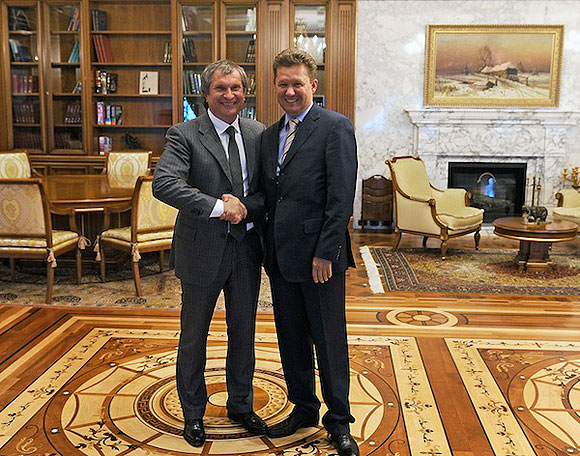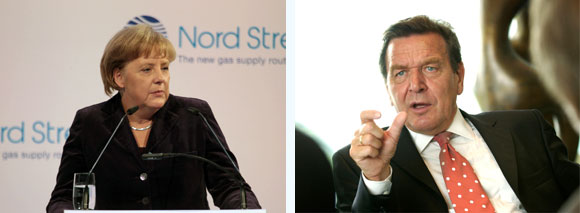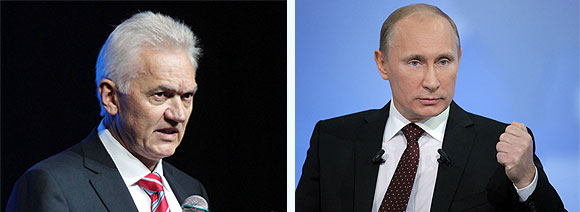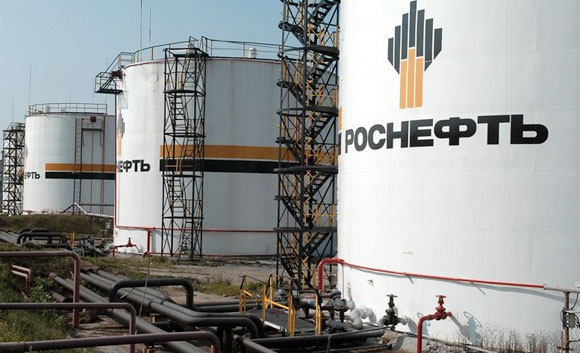Russia’s state capitalism reached a new high when Rosneft became the world’s largest publicly traded oil producer after its acquisition of TNK-BP. This new landscape is the result of the “national champions” strategy that was the heart of Vladimir Putin’s economic policy during his thirteen years in power. According to IMR economic advisor Igor Booth, the story of Gazprom, the world’s largest natural gas producer, provides good insight into the future of Rosneft and the Russian economy as a whole.

Rosneft CEO Igor Sechin (left) and Gazprom CEO Alexei Miller (right) preside over two largest monopolies in Russia. Apparently, both men are celebrating a new high of the state capitalism in the country.
As a member of the global corporate super-league, Gazprom is a good example of what national champions can achieve. For two consecutive years, the energy giant has earned more profits than any other company in the world. Between 1999 and 2007, Gazprom’s market capitalization skyrocketed, making it the third most valuable publicly traded company. In recognition of this success, Harvard Business Review named Alexey Miller, the company’s CEO, the best CEO of the emerging markets.
However, Gazprom’s major shareholder—the Russian Federation—has barely benefited from the company’s financial bonanza. The monopolist’s success was largely the result of wealth redistribution from its customers and the public to the pockets of company insiders. Today, however, Gazprom’s prospects seem uncertain because of major shifts in the world’s energy markets. Analysis of the company’s strategy over the past decade sheds some light on its future, as well as the future of its new sparring partner in the oil industry. An examination of the Gazprom case can help us understand the devastating consequences of state capitalism for the Russian economy.
Triumph of the Monopoly
Every corporate collapse is unique in its own way, but all successful companies are similar to each other in wielding substantial market power. Google, Apple, Microsoft, and Coca-Cola sustain their market dominance through patents, branding, and innovation. Gazprom’s financial success is based not only on high energy prices, but also on a successfully executed corporate strategy that has boosted the company’s market power.
Above all, the giant has managed to defend its exclusive access to Russia’s natural gas reserves. By the end of the 1990s, Gazprom’s monopoly on exploration and development had been eroded by the increasing penetration of Russian and international private companies, which had acquired a number of licenses for new natural gas fields. Soon after Putin came to power, this trend was reversed. Gazprom’s exclusive right to develop large natural gas fields was guaranteed by law. Within several years, the energy behemoth had swallowed all of its smaller competitors. These deals were facilitated by well-coordinated government campaigns against Gazprom’s acquisition targets.
After a barrage of tax claims, environmental fines, criminal charges, threats to withdraw licenses, and negative media campaigns, most owners were desperate to sell their natural gas assets at any price. In this way, Gazprom acquired control of Shell and TNK-BP’s large natural gas projects, forced Novatek to form an alliance, and bought up the assets of smaller companies Nortgas and Itera. These ruthless tactics blocked the emergence of independent natural gas producers.
The pipeline war proved a mixed bag for Gazprom. The development of liquid gas technology devalued investments in the construction of pipelines.
The second element of Gazprom’s strategy was to bundle its customers through long-term contracts and joint ventures. German, Italian, and French utilities perceived the establishment of close cooperative ties with Gazprom as an important competitive advantage. Deals with Gazprom turned these governments into the monopoly’s advocates in the European market. However, the dramatic 2008 drop in natural gas prices revealed these long-term agreements to be more favorable to Gazprom than to its partners. The Russian giant had outplayed the European energy behemoths.
“Divide and rule” has been Gazprom’s key tactic. Each client is offered its own natural gas price, which is kept secret. This way, the monopoly can extract from its consumers all of what they can pay. Smaller utilities, lacking access to any alternative gas suppliers, pay more than larger corporations, which are able to buy fuel elsewhere.
The third element of Gazprom’s strategy is its sustained control over the transportation network. The building of the Nord Stream pipeline through the seabed of the Baltic Sea secured the company’s independence from Belarus and Ukraine, which had previously leveraged their geographic position to receive healthy discounts from Gazprom. Today, Ukraine probably pays the highest price for natural gas than any other Gazprom client. Furthermore, Gazprom has successfully blocked all alternative pipeline routes designed to transport natural gas from the Caspian region to Europe.
However, the pipeline war proved a mixed bag for Gazprom. The development of liquid gas technology devalued investments in the construction of pipelines. Now these pipelines stay idle as Europe switches from pricy Siberian natural gas to liquefied gas and coal.

Nord Stream is Gazprom's largest energy and political project. The second stretch of the gas pipeline's was launched in October, 2012, thus doubling its capacities to 55 billion cubic meter of gas per year.
As a fourth prong of its strategy, Gazprom has lobbied for price increases on the domestic market. As a result, Russian companies today pay more for natural gas than their American peers. This was yet another victory for Gazprom over its customers. High domestic natural gas prices support the company’s profitability at a time of sluggish demand abroad.
Gazprom’s success is not driven by such traditional engines as new technologies, cost cutting, or entry into new markets. In fact, the monopoly’s output has fallen over the last ten years. The company consistently spends several times more on its investment projects than it declares. It overlooked shale gas and liquefied gas technologies, failed to acquire substantial expertise in offshore drilling, lost the fast-growing Chinese market, and missed the opportunity to promote natural gas as an automobile fuel in Russia.
Overall, Gazprom behaves as a typical monopoly, maximizing its profits through price increases and output cuts. The profits derived from innovations and cost cutting are beans compared with the profits drawn from a monopoly status and astonishing natural resource royalties.
Where Is the Money?
According to a popular Russian comic song, it is better to be a Gazprom shareholder than a prime minister. Indeed, the monopoly’s shareholders own a successful company with an outstanding financial performance and in theory should enjoy healthy dividends and a share in price growth. Alas, Gazprom is not generous when it comes to paying dividends. Ambitious expansion plans and a heavy debt burden consume most of the company’s profits. Still, the company’s capitalization skyrocketed at the beginning of the 2000s thanks to the liberalization of its ownership structure. Before 2003, foreigners were not allowed to invest in Gazprom. Those who knew about the government’s plans to eliminate restrictions on the company’s stock ownership made a killing.
Among the beneficiaries of Gazprom’s capitalization jump can be found many former and current government officials and well-connected Russian tycoons—but not the company’s major shareholder, the Russian Federation. The government could have realized profits by selling its shares when the company’s capitalization peaked. However, while the stock price grew, the government was buying, not selling, its shares to restore its formal control over Gazprom.

As Chancellor of Germany, Gerhard Shroeder (right) became Gazprom's number one ally in Europe, lobbying for its projects. Angela Merkel, who took over the office after Shroeder, continued to maintain close ties with the Russian gas company.
Though Gazprom leads the global energy ranks in terms of profits, its market value is less than that of the other major oil and gas companies. Investors do not anticipate that they will ever receive a fair share of the monopoly’s profits and doubt that the company will be able to sustain its current level of profitability in the future. Reflecting investors’ disappointment, the company’s capitalization fell from $364 billion in 2007 to just $110 billion in October 2012. During the same time-period, Gazprom fell in the Financial Times’ rankings of the world’s 500 most valuable companies from the third to the thirty-first position.
Gazprom’s multi-billion-dollar profits do not disappear without a trace. Contractors that sell the company everything, from pipes to consulting services, are the major recipients of the monopoly’s fortunes.
Though the government is not an efficient owner, some economists believe that in an emerging economy, it is much easier to collect taxes from a state-controlled company than a private one. In practice, the Russian natural gas industry has enjoyed favorable taxation in comparison with the private-owned oil industry. State-controlled Gazprom and Rosneft are the major recipients of the specially tailored tax exemptions for the development of new fossil fuel deposits.
In the absence of any direct financial benefits from Gazprom, the public may wish to receive indirect positive economic effects from the monopoly. The “national champions” policy promoted by Putin relies on the ability of these companies to execute ambitious breakthrough projects that are important for national economic development but are too risky and costly for private investors to pursue. Gazprom was entrusted with developing several projects that could have changed the economies of entire regions. Surprisingly, it was Shell that completed the only really breakthrough project in the Russian natural gas industry in the last thirty years. Like many others, the Dutch company was forced to sell its share in the project just months before it started generating profits. Most of Gazprom’s current projects are either postponed or frozen.
Until recently, Gazprom’s privileges were often justified by the low natural gas prices that it maintained in the domestic market. According to a common belief, Gazprom “subsidized the whole economy.” Though the natural gas price in Russia is still much lower than Gazprom’s export price, the domestic price could have been even lower had the market been liberalized. Low natural gas prices in the United States demonstrate how fair competition among producers can drive prices down.
Of course, Gazprom’s multi-billion-dollar profits do not disappear without a trace. Gazprom contractors that sell the company everything, from pipes to consulting services, are the major recipients of the monopoly’s fortunes. There are plenty of intermediaries surrounding the company, including those who buy its assets cheap and sell them high. Over the past ten years, there have been multiple cases in which Gazprom-related multi-billion-dollar construction or financial businesses emerged out of nowhere, only to disappear after their owners lost favor with the monopoly’s upper management.
Monopoly under Threat
The development of shale and liquid gas technologies poses a significant threat to Gazprom’s monopoly. European consumers now have more options to fill their energy needs. Environmentally obsessed Europe has even increased consumption of cheap but heavy-polluting coal only to avoid paying for expensive Siberian natural gas. The European Commission realized it was a good moment to intensify its investigation of Gazprom’s business practices. As a result, the company has had to offer multi-billion-dollar discounts to its largest clients in order to secure their loyalty.

Gennadyi Timchenko, a Finnish businessman and a close friend of Vladimir Putin, started to buy Novatek stocks in 2008. Today, Novatek tries to compete with Gazprom, infringing the company's monopoly on gas exports.
At the same time, the Russian government has changed its attitude toward the “national champion.” Both the president and his ministers have criticized Gazprom for its ineffectiveness and called for the overhaul of the company’s business model. The finance ministry finally succeeded in raising taxes on natural gas extraction. Fighting back, Gazprom announced a freeze of its key investment projects.
By far the largest threat to Gazprom comes from Putin’s old friends Igor Sechin and Gennadyi Timchenko. The latter owns 25 percent of Novatek, Russia’s second-largest natural gas producer. After Timchenko acquired a stake in Novatek, most of the company’s problems were miraculously resolved: it was allowed to form an alliance with Total and export gas to German consumers. Novatek’s two-digit growth in output has compensated for the decline in Gazprom production, once again demonstrating the advantages of private ownership.
Securing a monopoly no longer creates much value. If Gazprom continues to sell natural gas at premium prices, it risks losing its market share in the European market within several years. In contrast, if the company cuts prices and increases production, it can slow investment in shale gas drilling and liquid gas terminals across Europe. Gazprom still holds a cost advantage over shale gas and can offer a better alternative to the noisy and controversial drilling that is being pursued in densely populated Europe.
The liberalization of the natural resource sector can also help the current ruling clan to stay in power for longer. The survival of the regime depends on the pace of economic growth and the government’s ability to spend money. Considering that Russia has reached full employment, the growth of the natural resource industry remains the easiest way to boost the economy. Softening the investment climate in the oil and gas sectors is a relatively easy task compared with embarking on the painful structural reforms needed to improve overall conditions for business. Major international corporations will be eager to bring their technologies and money to Russia if they are guaranteed unrestricted access to natural resources and reasonable taxation.
By far the largest threat to Gazprom comes from Putin’s old friends Igor Sechin and Gennadyi Timchenko.
More significant economic policy changes could mean not only opening the sector to Russian and foreign private investors and ensuring equal access to the pipeline infrastructure, but also the full-scale restructuring of Gazprom. The company is too big and too powerful for the institutionally weak Russian state. Gazprom’s ineffectiveness and corruption, highlighted by the president and his ministers, are not accidental, but are caused by the intrinsic nature of the monopoly. The company’s size is the reason for high managerial costs and its intolerable level of corruption. The monopoly hampers the development of a competitive environment, triggering consolidation among its clients and suppliers. The recent electric power reforms are a good example of Gazprom leveraging its economic and political dominance to extend its monopoly even further. Gazprom became the largest electric power producer in Russia by acquiring the nation’s most precious electric power assets, including all power plants in Moscow and Saint Petersburg.
Like the magical ring from Tolkien’s trilogy, Gazprom seduces politicians into acting in the company’s best interests. The creation of a more competitive political system is impossible without a significant reduction of Gazprom’s power. Alas, many opposition leaders share the dream of a state-controlled natural resources sector. For example, Alexei Navalny, a popular new-generation politician, proposes corporate governance improvements for state-controlled companies as an alternative to privatization. This is exactly what Putin did ten years ago: he fired Gazprom’s corrupt management team, restored government control over the company, and returned assets that had been stolen from Gazprom in the 1990s. Popular support for state capitalism increases the risk that the current political system will reproduce itself for several more decades even if a new team comes to power.
The restructuring and privatization of the oil industry in the 1990s and of the electric power sector in the 2000s could be used as models for natural gas sector reform. Gazprom should be split into several companies based on their different activities (e.g., natural gas extraction, pipeline construction, distribution, etc.), while the production assets should also be split between different companies. The resulting competition in the sector will ensure its development, provide market-based pricing, and improve the overall structure of the Russian economy. The separate entities would be easier to privatize without running the risk of “hostile” investors taking control of the Russian economy. The sum of the capitalizations of the newly formed companies would most likely be higher than the current market value of Gazprom, which is traded with discounts to its international competitors.
Rosneft Is Likely to Repeat the Story of Gazprom
The ongoing acquisition of TNK-BP by state-controlled Rosneft demonstrates that Putin, though admitting some problems with Gazprom, still believes in the advantages of state capitalism. The case of Gazprom provides good insight into what will happen with Rosneft, a new “national champion” that will control almost half of the oil production in Russia.

By the end of October, 2012, Rosneft confirmed the buyout of another Russian oil company TNK-BP for $61 billion. After the deal is sealed, it will become the largest oil company in the world.
First of all, the Russian government will not receive substantial dividends from Rosneft in the foreseeable future. Rosneft is overloaded with debt and capital-intensive projects, so it won’t find the money to pay its shareholders. Money will go to Russians oligarchs and British investors, not Russian citizens.
Second, an increase in Rosneft’s share price is unlikely. Capitalization growth will be limited not only by the company’s poor corporate governance and Russia’s harsh investment climate, but also by the selling off of BP and Russian government stakes. Most analysts agree that the government pays private shareholders a fair price for their assets. Typically, private investors know better than governments when it is the right moment to cash out. Chances are, the Russian government won’t see the desired return on its investments.
Third, the effective tax rate on the oil industry will continue to fall. Rosneft will probably receive further tax exemptions.
Fourth, the oil industry will continue to stagnate. The largest West Siberian oil fields have surpassed their production peak. Exploration and development of new oil fields requires huge investments and state-of-the-art industry expertise. Competition could have stimulated private companies to invent new ways to extract profit. Rosneft, which will dominate the oil industry in Russia, will most likely concentrate on what it does best—acquiring new assets and lobbying the government for privileges.
Fifth, BP most likely will not become Rosneft’s real strategic partner. Instead, the British company will sell its stake in Rosneft in a couple of years, repeating the pattern of two other ambitious alliances: Amoco with Lukoil and E.ON with Gazprom. Under Russian corporate governance, a 20 percent stake does not guarantee any influence over a company’s strategy. The two BP directors on the Rosneft’s board will likely act only as window-dressing for Rosneft’s controversial business practices.
Sixth, Rosneft, like Gazprom, might become a part of Putin’s geopolitical machine. The economic interests of Rosneft may influence the Russian president’s political decisions. His stance toward the Middle East and other sensitive regions will affect both the world’s oil market and the fortunes of his friends. The peaceful resolution of the Iranian and Syrian crises might drive oil prices down, diminishing the profits of the president’s allies. Hence, Putin’s team is unlikely to be very keen on helping to resolve problems in the Middle East.
Rosneft, like Gazprom, might become a part of Putin’s geopolitical machine.
Finally, the privatization of Rosneft will become an even more controversial task. Any government would be reluctant to give up control of a company that dominates the country’s most important industry. In this situation, Rosneft’s shares could be sold only with significant discounts, since they would not give investors any influence over the company’s strategy.
In sum, the contribution of the energy sector to the nation’s economic growth seems poised to decline, as does government revenue from the oil industry. The government’s growing presence in the mineral resources sector increases the federal budget risks. Public finances will become even more dependent on oil prices. If oil prices fall, the government will simultaneously lose some of its tax income and face the depreciation of state assets in the oil industry. Even worse, considering Rosneft’s high debt-to-EBITDA ratio, the government might need to bail out the company with public money. If “diversification” and “elimination of oil dependency” were real policy goals, the government would have sold its stakes in Gazprom and Rosneft and used the proceedings to build infrastructure, fix the pension fund deficit, and top up rainy day funds. Those decisions would have fostered economic development and brought macroeconomic stability.
Enthusiasts of state capitalism cite Statoil, a Norwegian state-owned company, as a success story of government control over the mineral resources industry. However, plenty of more relevant examples could be found in Latin America. In most countries of the region, state-controlled companies face similar problems: the inability to develop new oil fields, a high level of debt burden, low efficiency, a lack of transparency, and, as a result, decreasing output. It will not take long to find out whether Rosneft more closely resembles the Scandinavian Statoil or its sibling Gazprom.